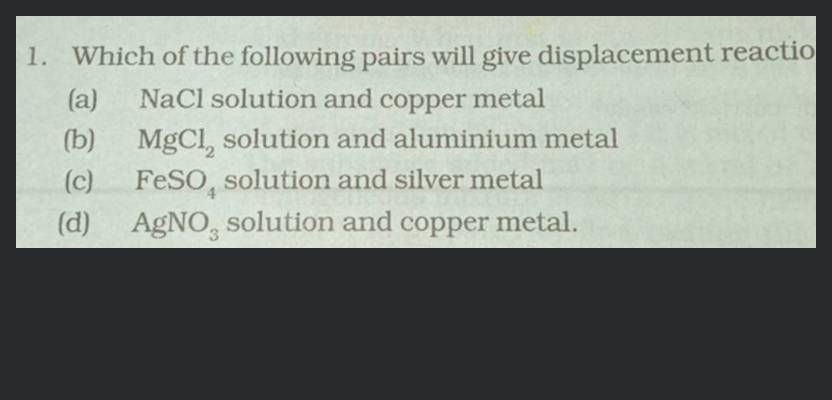Question
Medium
Solving time: 3 mins
Which of the following pairs will give displacement reactions?
Found 3 tutors discussing this question
Discuss this question LIVE
15 mins ago
 Text solution
Text solution Verified
Verified
Metal above in activity series are more reactive and can displace the less reactive metal.
(a) solution and copper metal
is more reactive than , thus it will not give diplacement reaction.
(b) solution and aluium metal.
can not replace because it is lower on the reactivity series.
(c) solution and silver metal
can not replace because it is lower on the reactivity series.
(d) solution and copper metal.
can be replaced by as it is above silver in the reactivity series. Therefore, this pair will give displacement reaction.
Hence, option is correct.
Was this solution helpful?
66
Share
Report
Filo tutor solutions (6)
Learn from their 1-to-1 discussion with Filo tutors.
19 mins
Uploaded on: 12/10/2022
Was this solution helpful?
89
Share
Report
6 mins
Uploaded on: 11/20/2022
Was this solution helpful?
138
Share
Report

One destination to cover all your homework and assignment needs
Learn Practice Revision Succeed

Instant 1:1 help, 24x7
60, 000+ Expert tutors

Textbook solutions
Big idea maths, McGraw-Hill Education etc

Essay review
Get expert feedback on your essay

Schedule classes
High dosage tutoring from Dedicated 3 experts
Practice more questions from Science (NCERT)
Q1
What would be the electron dot structure of carbon dioxide which has the formula
Q2
Which of the following pairs will give displacement reactions?
Q3
(i) Write the electron-dot structures for sodium, oxygen and magnesium.
(ii) Show the formation of and by the transfer of electrons.
(iii) What are the ions present in these compounds?
View allPractice questions from Science (NCERT)
Question 1
Medium
Views: 5,868
(a) What will be the action of gas on
(i) dry litmus paper ?
(ii) moist litmus paper ?
(b) Write a balanced chemical equation for the reaction taking place.
Question 2
Medium
Views: 6,039
(i) is a liquid at room temperature
(ii) can be easily cut with a knife.
(iii) is the best conductor of heat.
(iv) is a poor conductor of heat.
Question 4
Easy
Views: 5,957
Practice more questions from Metals and Non-metals
Question 1
Medium
Views: 5,823
a. Helium and argon are ________ gases.
b. Non-metals do not react with _____.
c. is an example of _______ reaction.
d. Metals can be drawn into thin wires because of their property of ________.
Question 2
Easy
Views: 5,642
A metal combines with a non-metal by the transfer of electrons to form a compound Y.
(i) State the type of bonds in Y.
(ii) What can you say about its melting point and boiling point?
(iii) Will it be a good conductor of electricity?
(iv) Will it dissolve in an organic solvent or not?
Practice questions on similar concepts asked by Filo students
Question 1
Views: 5,092
Question 2
Views: 5,337
Question 3
Views: 5,563


Stuck on the question or explanation?
Connect with our Science tutors online and get step by step solution of this question.
231 students are taking LIVE classes
| Question Text | Which of the following pairs will give displacement reactions? |
| Updated On | Apr 21, 2023 |
| Topic | Metals and Non-metals |
| Subject | Science |
| Class | Class 10 |
| Answer Type | Text solution:1 Video solution: 6 |
| Upvotes | 714 |
| Avg. Video Duration | 7 min |





